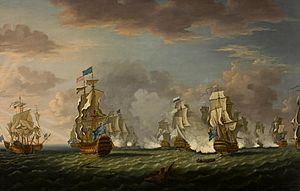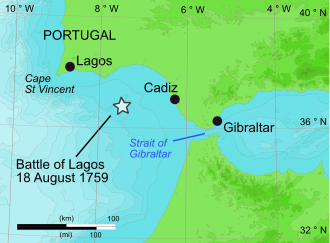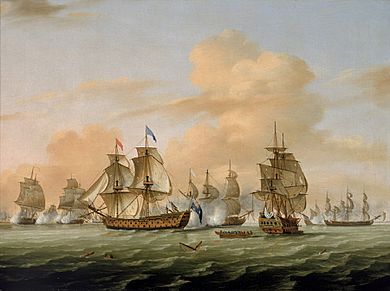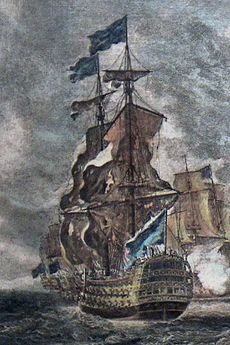Battle of Lagos facts for kids
Quick facts for kids Battle of Lagos |
|||||||
|---|---|---|---|---|---|---|---|
| Part of the Seven Years' War | |||||||
 The British Royal Navy defeats the French Mediterranean Fleet at the Battle of Lagos by Richard Paton |
|||||||
|
|||||||
| Belligerents | |||||||
| Commanders and leaders | |||||||
| Strength | |||||||
| 15 ships of the line 10 frigates 2 sloops 2 fireships |
12 ships of the line 3 frigates |
||||||
| Casualties and losses | |||||||
| 252 killed and wounded | 1000 killed and wounded 2 ships of the line destroyed 3 ships of the line captured |
||||||
The Battle of Lagos was a major naval battle fought in 1759 during the Seven Years' War. It took place over two days, from August 18 to 19, near the coast of Portugal. The battle involved a British fleet led by Sir Edward Boscawen and a French fleet commanded by Jean-François de La Clue-Sabran.
The French admiral, La Clue, was trying to sneak his fleet from the Mediterranean Sea into the Atlantic Ocean. His goal was to avoid fighting the British and sail to the West Indies. However, the British admiral, Boscawen, had orders to stop the French from reaching the Atlantic. He was told to chase and fight them if they tried.
On the evening of August 17, the French fleet successfully passed through the Strait of Gibraltar. But a British ship spotted them soon after. The British fleet was nearby in Gibraltar, busy with repairs. They quickly left port, even though many ships were not fully ready. La Clue knew he was being chased and changed his plan. In the dark, half of his ships did not follow him, but the British did.
The British caught up with the French on August 18, and a fierce fight began. Several ships were badly damaged, and one French ship was captured. The British had many more ships than the six remaining French ones. They chased the French through the night. On August 19, the last French ships tried to hide in neutral Portuguese waters near Lagos. But Boscawen ignored Portugal's neutrality. He captured two more French ships and destroyed the other two.
Contents
Why the Battle Happened
The Seven Years' War was a big global conflict that started in 1756. It involved many powerful countries. On one side were France, Austria, and Russia. On the other side were Britain and Prussia. France focused on fighting Britain at sea and in its colonies.
By 1759, neither side was winning the war easily. Both were struggling to pay for it. France, in particular, had money problems. Its navy was also having a tough time. It lacked experienced sailors and good leadership. Meanwhile, Britain's war effort improved under William Pitt. He planned to defeat France in North America and disrupt its trade.
To respond to Britain's successes, the French king, Louis XV, planned to invade Britain. An army of 17,000 soldiers was gathered in France. Nearly 100 transport ships were ready to carry them. The French plan needed their navy to protect these transport ships. However, the French navy often struggled to find enough skilled sailors. Many French sailors were prisoners of war or working as privateers (private armed ships). Also, conditions on French navy ships were often bad, with low pay.
The French had 73 "ships of the line," which were the largest warships. About 43 of these were in home waters, split between the Atlantic port of Brest and the Mediterranean port of Toulon. They needed about 25,000 sailors but were short by over 9,000. The British had 40 ships of the line in home waters and 15 in their Mediterranean fleet, based in Gibraltar.
Getting Ready for Battle
In May 1759, Edward Boscawen took command of the British fleet in the Mediterranean. He had 15 ships of the line and 12 frigates. Frigates were smaller, faster ships used for scouting and messages. Boscawen's job was to bother the French, protect British merchant ships, and keep Gibraltar safe.
By late July, the British ships needed supplies and repairs. Some had been damaged in earlier fights. The fleet went to Gibraltar, arriving on August 4. There, they began cleaning the bottoms of their ships to remove barnacles and seaweed. They also repaired their rigging and replaced broken spars.
While these repairs were happening, Boscawen received new orders. He learned that the French Mediterranean Fleet might try to join their Atlantic Fleet, probably at Brest. Boscawen was told to stop this. He sent two frigates to patrol the Strait of Gibraltar, a narrow passage, to warn him if the French tried to break out.
Earlier that year, British forces had captured Guadeloupe, a French island in the West Indies. This island was very important for sugar production. France sent nine ships of the line to help Guadeloupe, but they arrived after the island had already surrendered to the British.
News of this loss reached Paris. France decided to send its Mediterranean Fleet to reinforce the fleet in the West Indies. Admiral Jean-François de La Clue-Sabran received orders to sail at the end of July. His fleet, with twelve ships of the line and three frigates, left Toulon on August 5. La Clue planned to pass through the Strait of Gibraltar at night. He hoped to keep the British from knowing he had left the Mediterranean. He expected his fleet might get separated in the dark, so he ordered his ships to meet near the Spanish port of Cadiz.
On the evening of August 17, the French fleet passed through the strait. But soon after, the British frigate HMS Gibraltar spotted them. The French knew they had been seen. Realizing the British fleet was in Gibraltar, they expected a quick chase.
The sight of HMS Gibraltar, firing its guns to signal the enemy, surprised the British. Everyone rushed to get ready. Many captains and crew members were ashore. Some, including Boscawen, were dining miles away. Most ships sailed without their captains, led by junior officers. The senior officers followed as best they could. The flagship, HMS Namur, sailed with three captains and the admiral on board. Many officers and men were left behind.
Several British ships were barely ready for sea. Attaching sails to the masts of large warships was complex. Most British ships had to do this as they sailed, in the dark, with too few crew members. Some were even installing new masts. Ships were messy with repair materials and unorganized supplies. For example, HMS Prince had so many barrels on one gun deck that its guns could not be used. Despite these problems, within three hours of Gibraltar appearing, eight British ships of the line had left the harbor and were heading for the Atlantic. Several ships stayed behind, under Vice-Admiral Thomas Brodrick, with orders to sail as soon as they were ready.
Ships sailing at night usually showed lights to avoid crashes and stay together. The French ships likely did not use lights to stay hidden. French ships had secret orders to open after passing the Strait of Gibraltar. These orders told them to meet at Cádiz. But knowing the British had seen them, La Clue changed his plan. Instead of Cádiz, he decided to sail west, past Cape St. Vincent, and into the North Atlantic.
However, the French navy did not have a good system for night signals. Around midnight, La Clue's flagship, Océan, lit its stern lantern, turned left (west), and slowed down. Usually, a cannon shot would be fired to draw attention. But La Clue, who was ordered to avoid battle, might have skipped this to keep his move secret from the British.
The Battle Begins
At Sea
Eight of the fifteen French ships continued to Cádiz. It's unclear if they missed the flagship's signal or didn't understand it. At dawn on August 18, La Clue saw only six other ships. He ordered them to gather around his flagship and wait for the rest of the fleet. Around 6:00 am, a group of large ships appeared. La Clue stayed still, thinking they were his missing ships. Only when the sails of nine more British ships, Brodrick's squadron, appeared behind them did he realize all the ships were British.
The seven French ships sailed at the speed of their slowest ship, the Souverain. Boscawen ordered his ships to stay in formation. He wanted to prevent his fastest ships from attacking the French one by one and being defeated. The British ships were faster and had slightly better winds. This allowed them to slowly catch up to the French by the afternoon of August 18. Boscawen kept signaling his ships to "Make more speed." Some British ships had problems with their new sails splitting or spars breaking. This happened because the crews were pushing them too hard to catch the French.
At 1:00 pm, the French ships raised their battle ensigns (flags) and began firing from a distance. Ships of the line had most of their guns on their sides to fire broadsides. They had a few smaller guns at the back to fire behind them. This meant the French could fire at the British as they got closer, but the British could not fire back much. The French tried to damage the British ships' sails and rigging, but it didn't work well.
At 2:30 pm, the British ship Culloden attacked the last French ship, the Centaure. Both ships had 74 heavy guns. By this time, the French had formed a line, with their flagship in the middle. Boscawen wanted his fastest ships to attack the first French ships they met. Then, as the next British ship arrived, it should pass that fight and attack the next French ship in line. He believed any French ships left behind could be handled by Brodrick's squadron.
However, only Boscawen's flagship followed this plan. Only four of the seven French ships were attacked. Centaure was attacked by five British ships. It fought for five hours, slowing down the British chase. It finally surrendered after being badly damaged, with over a third of its crew killed or wounded.
Meanwhile, Boscawen pushed forward in his 90-gun flagship, Namur. He wanted to fight the largest French ship, La Clue's 80-gun flagship, Océan. Namur passed three French ships, taking a broadside from each. Boscawen ordered his crew to lie down to avoid casualties and not fire back. By 4:00 pm, Namur was close enough to Océan to open fire. A quick, intense fight followed. Océan had nearly 200 men killed or wounded, including La Clue. Namur lost one of its three masts and the top parts of the other two. With Namur unable to move well, Océan, also badly damaged, fled. Boscawen then moved his flag to Newark.
As the sun set, the six remaining French ships continued to flee northwest. The British ships that were not damaged too badly followed close behind. There was enough moonlight for the British to keep sight of them. However, the two fastest French ships, Souverain and Guerrier, escaped into the Atlantic during the night.
The badly wounded La Clue now commanded only his flagship and three other ships of the line: Redoutable, Téméraire, and Modeste. None of these had been in the main fight yet. Giving up hope of escape, he led his remaining ships to a small river west of Lagos in Portugal. Portugal was a neutral country, so it would be against the law for Boscawen to attack them there. There was also a small Portuguese fort overlooking the area, which La Clue might have hoped would protect them.
Off Lagos
As Boscawen approached in Newark, the Portuguese fort opened fire. He stopped his ships outside the fort's cannon range. Then, he chose several ships to attack the French, "without any regard to the laws of neutrality."
The British ship America attacked Océan. It fired a broadside from close range and demanded the French surrender. The French, who were already leaving their ship, lowered their flag (surrendered). The British could not pull Océan off the shore because it was stuck firmly. So, they took off the remaining crew and set the ship on fire. Several hours later, around midnight, the fire reached its gunpowder storage, and the ship exploded.
Three ships from Brodrick's squadron were sent after the Redoutable. HMS Prince fired into it many times and then boarded it. Redoutable was also stuck on the beach. Like Océan, it was set on fire and exploded hours later.
After seeing Océan and Redoutable burn, and seeing HMS Jersey sailing towards them, the crew of Modeste fled or surrendered. Modeste was then towed out to the British fleet, with little damage. The Portuguese forts fired on Jersey during this operation. The last French ship, Téméraire, was attacked by Warspite at 2:45 pm. Its crew refused to surrender. Warspite moved to a position where it could fire into Téméraire's back, where the French could not easily fire back. After an hour, Téméraire also surrendered and was towed away.
What Happened After
The French lost 500 men killed, wounded, or captured. The British had 56 killed and 196 wounded. La Clue, who was badly wounded, was taken ashore before the British arrived and survived. He was promoted five years later.
The battle did not stop the French plans to invade Britain. The two French ships that escaped the battle eventually reached Rochefort. The five French ships in Cadiz were blocked by Boscawen's second-in-command, Admiral Brodrick. They were told to go to French Atlantic ports if they could escape. This was to help the fleet in Brest. But by the time they escaped Brodrick during a winter storm in January 1760, the French Atlantic Fleet had been destroyed at the Battle of Quiberon Bay. So, they returned to Toulon instead.
When he heard about the victory, the British prime minister, the Duke of Newcastle, said he was no longer afraid of an invasion. Boscawen's government fully supported his actions, even though he had broken Portugal's neutrality. They convinced Portugal that it was an accident. Three years later, Spain and France used this breach of neutrality as a reason to declare war on and invade Portugal.
Boscawen, his captains, and their crews were celebrated in Britain. After their repairs were finished, some of Boscawen's victorious ships joined Admiral Edward Hawke's fleet off Brest. Five of them were with Hawke when he destroyed the Brest fleet in Quiberon Bay in November.
Historians consider the Battle of Lagos a "definitive" (clear and final) victory. It was one of many British victories in 1759. This year became known as an annus mirabilis (Latin for "year of wonders").
The three captured French ships, Centaure, Modeste, and Téméraire, later served in the British navy. A young officer named Pierre André de Suffren was on board Océan. He later became a famous French admiral. A young slave named Olaudah Equiano, who later became an important abolitionist in England, was on the British side during the battle. He wrote about the battle in his autobiography, The Interesting Narrative of the Life of Olaudah Equiano.
Ships in the Battle
Britain
Ships of the line:
- Namur 90 (flagship)
- Prince 90
- Newark 80
- Warspite 74
- Culloden 74
- Conqueror 70
- Swiftsure 70
- Edgar 64
- St Albans 64
- Intrepid 60
- America 60
- Princess Louisa 60
- Jersey 60
- Guernsey 50
- Portland 50
Frigates:
- Ambuscade 40
- Rainbow 40
- Shannon 36
- Active 36
- Thetis 32
- Lyme 24
- Gibraltar 24
- Glasgow 24
- Sheerness 24
- Tartar's Prize 24
Sloops:
- Favourite 16
- Gramont 16
Fireships
- Aetna 8
- Salamander 8
France
Ships which participated in the battle:
Ships of the line:
- Centaure 74 – captured 18 August
- Océan 80 (flagship) – run aground and burnt 19 August
- Redoutable 74 – run aground and burnt 19 August
- Téméraire 74 – captured 19 August
- Modeste 64 – captured 19 August
- Souverain 74 – escaped
- Guerrier 74 – escaped
Ships which became separated at night and sailed to Cadiz:
Ships of the line:
- Triton 64
- Lion 64
- Fantasque 64
- Fier 50
- Oriflamme 50
Frigates:
- Minerve 26
- Chimère 26
- Gracieuse 26
Images for kids












